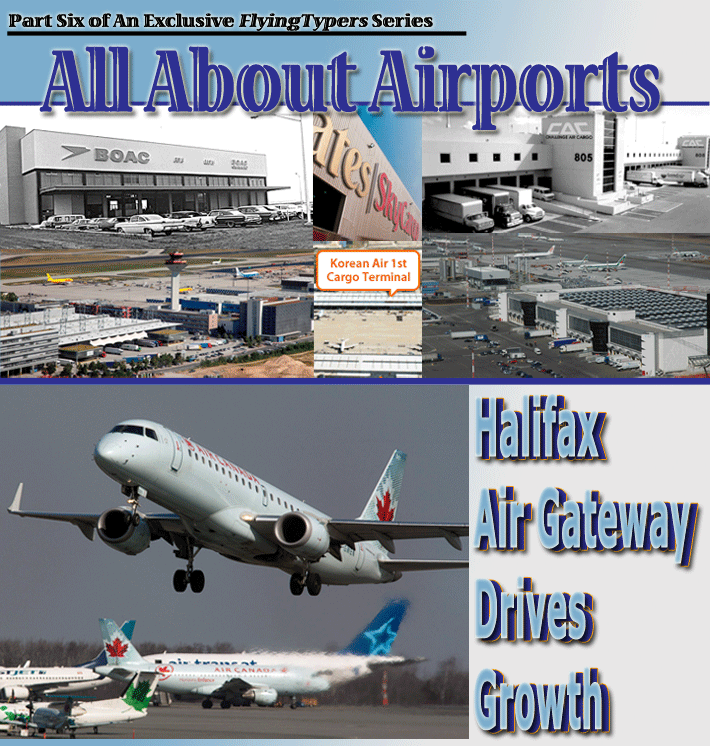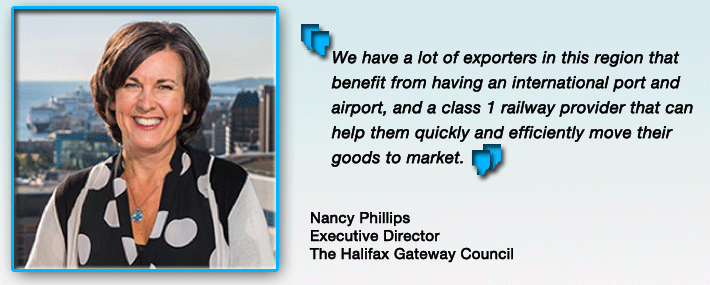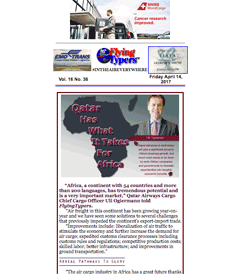
IT TAKES A VILLAGE . . . For
most air passengers traveling between Europe and North America, a small
airport on the eastern coast is the first or last landfall to be seen
from 40,000 feet in the air. Today, Halifax Stanfield International Airport—which
serves the Halifax municipality and a population of about 420,000—is
busy building key partnerships to foster growth.
Closest To
Europe
Halifax is the capital city of Nova Scotia,
which has a total population of less than 1 million people.
Located on the east coast of Canada, Nova Scotia is the closest mainland
point to Europe.
Too Big To
Be Miniscule
Halifax Stanfield is a small part of the
country and miniscule on a global scale.
Despite that, you may be surprised to learn
that the gateway handled 3.7 million passengers and over 32,000 tons of
freight through the airport in 2015.
Coastal Advantages
Above & Beyond
Another enormous advantage of the airport’s
coastal location is its immediate proximity to the air and ocean routes
utilized every day by carriers between North America and Europe.
Great Seafood
The Halifax coastal waters are also home
to the finest hard-shell lobsters in the world. “Our exporters traditionally
ship millions of pounds of live lobster annually by truck to the northeast
U.S. and by air to key markets in Europe,” said a spokesperson for
Halifax Stanfield International Airport.
“More recently, our live lobster exports
to China have grown by more than 400 percent.”
Best Airport
You Never Hear About
With these natural advantages, there are
also disadvantages.
As with many airports, “Halifax struggles
to market ourselves with limited funds as we try to attract additional
passenger and cargo capacity,” the spokesperson said.
Like all of the major Canadian airports,
Halifax International Airport Authority (HIAA) is a locally controlled,
non-share capital corporation, incorporated in November of 1995.
On February 1, 2000, Halifax International
Airport Authority took over the management of Halifax Stanfield International
Airport. Transport Canada relinquished its role of operator for the role
of landlord and regulator instead.
This agreement requires the facility to
pay a significant amount of airport rent to Transport Canada, in excess
of $6 million CDN in 2015.
Tired of
Paying Rent
“With incentives a growing component
of business development, this is money we would prefer to utilize ourselves,”
the spokesperson said.
“From a recent Financial Post article
(April 14, 2016): ‘the nine largest U.S. airports received $423
million from federal and state governments in 2011, according to a report
prepared for the National Airlines Council of Canada by Fred Lazar, an
economist at York University’s Schulich School of Business.’
“By contrast the eight largest Canadian
airports paid $266 million in rent to Ottawa, or about 10 percent of their
total revenue. In total, the Federal government collected nearly $1 billion
in airport rent and security fees in 2015.”
Sticking
Together
“Facing this adversity head on, our
small ‘village’ quickly became aware that we needed all our
community partners to share expertise and pool our resources, including
funding.
“As with airports everywhere, we work
alongside layers of municipal, provincial, or state as well as federal
economic development groups with the common stated goal of growing our
economies by attracting and/or retaining business, tourism, and trade.”
Halifax Gateway
Council Initiative
“Back in 2003 the C.E.O. of our Airport
approached his counterparts in key sectors such as our port, the major
rail operator and trucking companies, as well as the economic development
arms of the City of Halifax and the Province of Nova Scotia.
“From those initial conversations,
the Halifax Gateway Council (HGC) was established in 2004 and provides
a forum for transportation providers and stakeholders in the Halifax region
to work collaboratively to improve the efficiency and competitiveness
of the Gateway for the movement of goods and people.
“Funded by both the public and private
sector, the HGC seeks to establish partnerships to increase business through
the Halifax Gateway.”
Success Story
“The Halifax Gateway is essential
for local companies that want to do business with the world.
“It offers advanced logistics, multimodal
transportation and easy access to North American and global markets,”
explains Nancy Phillips, executive director of the Halifax Gateway Council.
“It includes the Port of Halifax,
Halifax Stanfield International Airport, two container terminals, CN Rail,
the freight forwarding, logistics and warehousing sector and Nova Scotia’s
Class 1 highway infrastructure.
“The Halifax Gateway Council fosters
cooperation between key players from a diverse set of sectors including
the Port, Airport and CN, along with transportation providers, exporters
and other organizations that benefit directly from an efficient and competitive
gateway.”
 |
Cooperation
Is Harmonious
“We work together and put a common
voice to key markets and relay the interesting things that are going on
in the business community,” said Ms. Phillips.
“It’s easier for governments
and businesses to understand what the priorities are when they hear that
unified voice.”
The Big Four
Four committees (made up of municipal, provincial
and federal government organizations as well as private businesses) promote
the Gateway globally.
Air Gateway
Committee Vita
The Air Gateway Committee is made up of
the Airport, Nova Scotia departments of Business plus Transportation &
Infrastructure Renewal and Tourism, Nova Scotia Business Inc., Destination
Halifax and the Atlantic Canada Opportunities Agency.
The committee looks for ways to work on
collaborative marketing campaigns that will sustain and grow air routes
and capacity.
This includes increasing access for cargo
planes in and out of Halifax’s Airport, attracting new airlines,
and increasing the number of international travelers.
The number of direct flights into Halifax
for consultants and workers can be a key factor in an international company
choosing the Gateway.
Trade Missions
Halifax Gateway Council members regularly
participate in trade missions to highlight the benefits of doing business
in Halifax for foreign governments and businesses.
What’s
Next
While Halifax’s proximity to growing
markets like India and China make it attractive to international concerns,
that same geography also make the Gateway well-suited to accommodate Atlantic
Canadian companies who wish to take advantage of the low Canadian dollar
and venture into international markets.
“Two-way trade is so important,”
says Phillips.
“We have a lot of exporters in this
region that benefit from having an international port and airport, and
a class 1 railway provider that can help them quickly and efficiently
move their goods to market.”
Growth Picture
“From 2001, when eight carriers served
Halifax, we now have 17 scheduled and seasonal airlines plus a significant
presence from key integrators like Cargojet and FedEx as well as two weekly
freighters flown by Korean Air Cargo and now joined by Qatar Airways Cargo,”
said the Halifax Stanfield International Airport spokesperson.
“Cooperation and coordination have
been crucial.
“Try a deep dive to Halifax,”
the spokesperson said,” and you may find that the water is fine.”
Geoffrey
|





